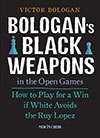 Bologan's Black
Weapons in the Open Games
Bologan's Black
Weapons in the Open Games
How to Play for a Win if White Avoids
the Ruy Lopez
by Victor Bologan
2014
New in Chess
http://www.newinchess.com/
528 pages
Price € 29,95
ISBN 978-90-569-1543-8
The great Victor Bologan comes with a move to move repertoire book,
based on a complete repertoire with 1.e4 e5 against everything except
The Ruy Lopez.
Included are the good old romantic lines, as the King’s Gambit where I
for
example found, the following suggestion from Bologan against the
Rosentreter’s Gambit:
1.e4 e5 2.f4 exf4 3.Nf3 g5 4.d4 g4 5.Ne5 Qh4+ 6.g3 fxg3 7.Qxg4 Qxg4
8.Nxg4 Nc6 9.c3 d5 10.Ne3 dxe4 11.hxg3 Nce7!?
And in Polerio’s Gambit: 1.e4 e5 2.f4 exf4 3.Nf3 g5 4.Bc4 g4 5.0-0 gxf3
6.Qxf3 Qf6 7.e5 Qxe5 8.Bxf7+ Kxf7 9.d4 Qf5 10.g4 Qg6 11.Bxf4 Nf6 12.Be5
In the old monograph on the King’s Gambit,glazkov and Estrin were
betting on this position but as Bologam explains,white’s attack is
doomed to fail.
12…Be7 13.Nc3 d6 14.Bxf6 Bxg4 15.Qd5+ Be6+ 16.Qg5 Bxf6 17.Rxf6+ Qxf6
18.Rf1 Nd7 19.Rxf6+ Nxf6 20.Kf2 c6 where white has won the queen but
the price is to high.
Recommended against the Moller Attack is the simple move order with
9..Ne5,:
1.e4 e5 2.Nf3 Nc6 3.Bc4 Bc5 4.c3 Nf6 5.d4 exd4 6.cxd4 Bb4+ 7.Nc3 Nxe4
8.0-0 Bxc3 9.d5 Ne5 10.bxc3 Nxc4 11.Qd4 0-0 12.Qxe4 Nd6 13.Qd3 b6
14.Re1 Bb7 15.Bg5 f6 16.Bf4 Nf7 17.d6 cxd6 18.Bxd6 Nxd6 19.Qxd6 Bxf3
20.gxf3 Rf7,on amateur level ,some knowledge of the Moller is essential.
Probably better as the Moller Attack is the Bird Variation which had
its heyday on the second half of the 80s: 1.e4 e5 2.Nf3 Nc6 3.Bc4 Bc5
4.c3 Nf6 5.b4 Bb6 6.d3 d6 7.a4 a5 8.b5 Ne7 9.0-0 Ng6 10.Nbd2 0-0 11.Bb3
c6 12.bxc6 bxc6 13.Nc4 Bc7 14.Re1 Re8 15.Rb1 d5 16.exd5 cxd5 17.Na3 Bg4
18.h3 Bh5 and black has the initiative on the king’s dide.
Victor Bologon is a man who is not afraid to show his secrects to the
readers of this book,for example the line 1.e4 e5 2.Nf3 Nc6 3.Bc4 Nf6
4.Ng5 d5 5.exd5 Na5 6.d3,The Morphy line has a bad reputation,but6…. h6
7.Nf3 e4 8.Qe2 Nxc4 9.dxc4 Bc5 10.0-0 0-0 11.Nfd2 Bg4 12.Qe1 Qd7 13.Nc3
Rfe8 14.Nb3 Bd6 15.Qe3 c6 16.h3 Bh5 17.c5 Be5 18.d6 b6 19.cxb6 axb6
20.Qxb6 Bxd6 could just be playable for white.
Good memories gives me the game against Chandler who went for the
Belgrade Gambit:
Chandler C.ENG (2560) - Elburg J.NLD (2475) [C47]
World Championship 3 of the WCCF,corr 1996
1.e4 e5 2.Nf3 Nc6 3.Nc3 Nf6 4.d4 exd4 5.Nd5 Nb4 6.Nxd4 Nxe4 7.Bc4 Nxd5
8.Bxd5 Bb4+ 9.c3 Nxc3 10.bxc3 Bxc3+ 11.Kf1 As Bologan writes: 11.Bd2
would be good if black capures on a1,but after 11…Bxd4 the position
looks hopeless.11… Bxa1 12.Ba3 Qf6 13.Qxa1 Qa6+ 14.Ne2 Qxa3
15.Qxg7 Rf8 16.g4 c6 17.Rg1 cxd5 18.Rg3 Qd6 19.Nd4 Kd8 20.Nb5 Qb4
21.Rb3 Qc5 22.Kg2 f6 23.Rc3 Qe7 24.Qh6 Rg8
0-1.
Included is a fast lane repertoire for the players who have not much
time to study chess.
Very useful is the index of games where I found references to a small
2200 games all presented in a separate index.
All variation are presented in blacks view and that makes this book
very readable!
Conclusion:Buy this book if you have
plans to play the Open Games with Black!
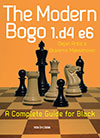 The Modern Bogo 1.d4 e6
The Modern Bogo 1.d4 e6
A Complete Guide for Black
by Dejan Antic & Branimir
Maksimovic
2014
New in Chess
http://www.newinchess.com/
476 pages
Price € 29,95
ISBN 978-90-569-1495-0
Grandmaster Dejan Antic and chess coach Branimir Maksimovic
provide the reader with a well thought repertoire move to move
repertoire book,as they did in there
work The Modern French,but now they concentrate on the move 1.d4.
Again they go for the move 1…e6 and after for example: 1.d4 e6
2.c4 Bb4+ 3.Bd2 Bxd2+
4.Qxd2 Nf6 5.Nf3 b6 6.Nc3 Bb7 7.Qf4 0-0 8.e4 Nc6 we reach less explored
lines, but as both authors explain more than 90 percent of the
lines are also reached throw standard transposition with 1.d4 Nf6 2.c4
e6 and that makes this
work extremely interesting.
Highly instructive are the words after 8…Nc6!?N Now a hyper modern
position merges. Black is not interested in the centre,but exclusively
in the development
and activity of his own pieces. The essential question is: can the
activity of black’s minor pieces compensate for the opponent’s strong
centre?
This all is well explained with around 1.5 page of readable text where
the authors explain the use of activity and flexible pawn
structure.
In section three you shall find a detailed coverage of the Accelerated
Bogo Indian 1.d4 e6 2.c4 Bb4+ 3.Bd2 a5 or the so called Eingorn System.
After 1.d4 e6 2.c4 Bb4+ 3.Bd2 a5 4.Nf3 d5 5.g3 we reach a Catalan type
position.
And with the moves: 1.d4 e6 2.c4 Bb4+ 3.Bd2 a5 4.Nf3 d5 5.Qc2 Nf6 6.a3
Be7 7.Nc3 0-0 8.Bg5 Nbd7 9.e3 we enter a position from the Queen’s
Gambit,where …a7-a5 is an inadequate response to a2-a3.
Interesting alternatives are lines as 1.d4 e6 2.c4 Bb4+ 3.Nc3 c5 but
they the subject of this wonderful written book.
Conclusion: Seen the highly
instructive explanations I only can say these two books from Antic and
Maksimovic belong to the absolute top!
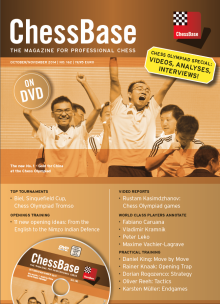 ChessBase Magazine issue 162
ChessBase Magazine issue 162
2014
October/November
http://www.chessbase.com
E-Mail
info@chessbase.com
ISSN 1432-8992
Price Euro 19.95
The main tournament file with all the tournaments is good for 3790
entries where a small 32 of them cover excellent annotations.
For example please see the following analyses from Peter Leko: (2737) -
Naiditsch,Arkadij (2705) [D36]
Dortmund 42nd Dortmund (5), 18.07.2014
[Leko,P]
My opponent is an excellent 1.e4 player, so it felt like a good
decision to try 1.d4 and at the same time avoid a possible Berlin Wall.
Which had anyway blocked me enough in this tournament.
1.d4 Nf6 2.c4 e6 3.Nc3 Inviting the Nimzo... 3...d5 ...no,thanks!
4.cxd5 exd5 In my preparation I had anticipated 3...d5, but
expected Arkady to play 4...¤xd5 here.
5.Bg5 c6 We ended up in some classical Queen's Gambit. I am not
revealing any big secret, if I remark that neither of us is a big
expert of it! A typical situation in modern chess!
6.Qc2 Be7 7.e3 Nbd7 8.Bd3 Nh5 Heading for the Carlsbad structure.
[Last year in the same tournament Adams played 8...h6 9.Bh4 Nh5 10.Bxe7
Qxe7 against me. The position is full of small nuances. It is
impossible to say what is best. In some positions Black prefers the
pawn to be on h6, but sometimes it is better to have the h7-g6
structure. It is a matter of taste or analysis?] 9.Bxe7 Qxe7 10.Nge2
Nhf6 This is not very standard, 10...g6 or 10...¤b6 are played
much more frequently. However I had the feeling that my opponent did
not want to touch his kingside pawns till I decided where I would put
my king.
11.0-0 Nb6 12.Rae1 I was happy to choose this plan as I felt that
this is the most ambitious. 12...0-0 13.Nf4 It took me quite some time
to decide to put my knight on f4 or to continue with the standard
¤c1 plan. Finally I convinced myself that normally White plays
¤c1 because usually the black knight is on h5 and the knight can
not get to f4. In any case White tries to prepare e3-e4 by playing
f2-f3. 13...Bd7! A far from obvious move played after long thought.
After careful calculations Black understands what is really going on in
the position. [The lazy and natural 13...g6 could have been answered by
14.f3! and now after 14...g5 the positional pawn sacrifice is strong
with 15.Nfe2! Qxe3+ 16.Kh1 and White gets a very strong attack by
simply playing ¤d1, £d2, ¤g3, ¤e3 and the
weakness of the f5-square and Black's king vulnerability will tell.]
14.g3!? This move might look mysterious, but in fact I think it is
fairly logical. White wants to prepare f2-f3 without allowing the
annoying g5-reaction. [I spent a lot of time trying to make the
immediate 14.f3 work, but in all the lines Black seemed to be in
time 14...g5! 15.Nh3 (The same idea as before with 15.Nfe2 Qxe3+ 16.Kh1
is missing a crucial tempo in the variation 16...Rae8 17.Nd1 Qe7 18.Qd2
h6 19.Ng3 Qd6 20.Ne3 Qf4! and Black is in time!; 15.Qf2 I even
considered this bullet style move 15...gxf4 16.exf4 Qd6 17.Qh4 Kh8
18.Re5 looks beautiful, but after 18...Rg8 soberness prevails and there
is no follow-up; £h6 can always be met by ...¤e4!)
15...Bxh3 16.gxh3 Kh8 17.Kh1 Rae8 18.Qf2 Nh5 is possible but maximally
double-edged. I had no intention to change the character of the game so
quickly.;
The other move was the immediate 14.e4 but unless it wins material it
is better to refrain from such a move. 14...dxe4 15.Nxe4 Rfe8! and
Black has nothing to worry about.] 14...Qd6 Again best. The queen
belongs here in any case, but it is not yet clear how to place the
rooks.
15.f3 Following the plan. 15...Rfc8? I was surprised by this move
and believe it to be a serious inaccuracy. [There was no reason
why Black should have not continued more naturally with 15...Rac8!
16.g4 (16.Qf2 c5) 16...c5! A far from obvious tactic that works with
the rook on f8, but it does not with the rook on a8! 17.Qd2 (The
difference is in the line 17.dxc5 Qxc5 18.g5 d4! 19.gxf6 g6! and here
Black is doing well! While with the rook on a8 White has the stunning
¥e4 here as we will see in the other line.) 17...g6 with a complex
fight, but about equal chances.;
It is very important to mention that the standard reaction to any f2-f3
is usually c6-c5, but here it does not work yet because of a nice piece
of tactics. 15...c5? 16.dxc5 Qxc5 17.Ncxd5! and White wins a pawn!]
16.g4 I really liked my position and did not want to simplify it. The
computer likes [16.Qf2 more, but I do not agree 16...c5 17.e4 (17.dxc5
Rxc5 18.e4 dxe4 19.Nxe4 Nxe4 20.Bxe4 also did not impress me at all)
17...dxe4 18.Nxe4 Nxe4 19.Bxe4 Rab8 and this is very drawish.] 16...g6
A necessary move. Here the tactical solution with the immediate c6-c5
actually backfires on Black! [16...c5? 17.dxc5 (17.g5? runs into a nice
refutation 17...cxd4! 18.gxf6 and now both 18...g6 (and 18...Qxf6 are
good for black) ) 17...Qxc5 (17...Rxc5 18.g5 d4 19.gxf6 dxc3 20.Bxh7+
Kf8 21.fxg7+ Kxg7 22.Be4 is simply good for White) 18.g5 d4 19.gxf6 g6
and here comes the incredible move 20.Be4!! and White wins material
20...dxc3 21.Bxb7] 17.a3 I had the feeling that I had a very good
position, but over the board it was very difficult to understand all
the finesses. [The text move is a good prophylactic, but it was the
right moment to play 17.h4! I wanted to play like this as the plan h4
followed by £h2 was screaming to be played, but the real point
comes much later 17...c5 18.Qh2 cxd4 19.exd4 Qb4 was really bothering
as there is no good way to defend the d4-pawn and it falls with check!
(The reason behind my 17.a3 move)
But the engines come up with an excellent solution to the problem, just
ignore it... 20.g5!! Qxd4+ 21.Kh1 Ne8 (21...Nh5 is also bad after
22.Nce2 Qxb2 23.Nxh5 gxh5 24.Qf4! followed by ¤g3 is very
strong) 22.h5! and suddenly at a high depth the computer already gives
an almost winning advantage for White! If you do not believe it, please
check it out!] 17...c5 18.Qd2 Now unfortunately I had to lose this
tempo as £h2 is not yet available. On the other hand Black has no
way to use this tempo. A sad decision as after this exchange it is
obvious that White will have long lasting pressure, but it was the best
option. Now Black is fully focused on exchanging as many pieces as
possible to defend the passive position. 18...cxd4 19.exd4 Bc6! The key
idea of Black's defence. Defending the d5-pawn by the bishop which
anyway has no other prospects.
20.g5 White had a couple of interesting options, it was difficult
to decide which gives the best chances. [I also considered 20.h4 Re8
21.Qh2 now that ...£b4 is covered 21...Rxe1 Black exchanges as
much as possible 22.Rxe1 Re8 23.Rxe8+ Nxe8 and here 24.Nfe2 felt like
some slight pressure, but I wanted more.] 20...Nfd7 21.Re2 [As it
turned out after the game 21.h4! was strong here 21...Re8 22.Qh2! After
all! 22...Nf8 23.h5 and Black can not exchange both rooks as the
d5-pawn is hanging at the end! During the game I had missed this small
but very important detail!] 21...Re8 22.Rfe1 Rxe2 23.Rxe2 Nf8 24.h4 Re8
25.Rxe8 Bxe8 26.Qe3 This was my idea and that is why I did not play
£h2 at the end. I thought that at some point £e5 might be a
threat. 26...Bc6 27.Kg2 [The hasty 27.Qe5? runs into 27...Qxe5 28.dxe5
Nfd7 and Black is fine.] 27...f6 It looks like Black has solved all his
problems and a draw is very close, but in fact the position is not that
simple.
28.gxf6! A difficult decision, but a very good idea! At the end I
felt that this paradoxical decision gives me chances! 28...Qxf6 29.Kg3
At first it looks like there is nothing here, but if White gets
¤d1-f2-g4 suddenly it looks very unpleasant. We were down to 10
minutes each and with little time it is very difficult to defend for
Black. White's play is very easy while Black has to take a difficult
decision: to try just to sit and wait or try to do something because
there is no guarantee that by just sitting Black could hold it.
29...Kf7 A natural, good move. [I was hoping that my opponent would get
impatient here and go for 29...g5 when I considered 30.Nh5!? very
dangerous for Black (30.hxg5 Qxg5+ 31.Kf2 Qh4+ 32.Kg1 Qg5+ 33.Kf1 is
solid and good) 30...gxh4+ 31.Kf2 Qd6 32.Qg5+ Ng6 33.f4 and this felt
very bad for Black.] 30.Nd1 Following the plan. 30...Nbd7 Defending
such position is practically always very difficult. With an engine's
help Black could have probably saved the game by playing ...g5 now, but
it is very hard to calculate such lines. [30...g5! 31.hxg5 (31.Nh5 This
idea is again interesting 31...gxh4+ 32.Kf2 Qd6 33.Qg5 looks again very
promising, but with a long line the computer holds it by some miracle
33...Qh2+ 34.Ke1 Nbd7 35.Ne3 Ne6 36.Qh6 Qg1+ 37.Kd2 Qg5! 38.Qxh7+ Ke8
and apparently Black survives) 31...Qxg5+ 32.Kf2 Nc4 I had seen this
line during the game and assumed that I would be able to find
something, but not against a computer! 33.Bxc4 dxc4 34.Nc3 looks awful,
but Black is in time to start checking 34...Qh4+ 35.Ke2 Qh2+ 36.Kd1
Qh1+ and Black holds.] 31.Nf2 g5? And now it is too late! [Black could
have exchanged some more pieces with ...¤e6, but after 31...Ne6
32.Ng4 Qxf4+ 33.Qxf4+ Nxf4 34.Kxf4² it is very dangerous. White
has total domination despite the little material.;
Best was probably to try 31...Qe7 when White should keep the queens
32.Qd2 and the torture continues, but Black has decent chances to
survive.] 32.hxg5 Qxg5+ 33.Kh2 Qe7 Black's play was based on this
move,but as it turns out that the last moves only helped White.
34.Ng4! Now I do not mind the exchange of queens! 34...Qxe3
35.Nxe3 I think Black is lost here as there is no defence against the
White's king marching to g5 when Black will end up losing a pawn sooner
or later. 35...Nf6 36.Kg3 The king starts the march. 36...N8d7 37.Kh4
Black has no defence. If Black tries h6 than ¤f5 wins the
h6-pawn right away. 37...Nb6 Desperation in time trouble. Black wants
to get the knight via c8 to e7 or d6, but it is just not in time.
38.Kg5 Nc8 39.Ng4! Now it is over as Black loses the h7-pawn by
force. 39...Nxg4 40.fxg4 Nd6 41.Bxh7 The rest does not need any
commentary. 41...Nb5 42.Ne2 Kg7 43.Bd3 Nd6 44.Kf4 Bd7 45.Nc3 Bc6 46.Nd1
Nf7 47.Ne3 Nd8 [47...Kf6 48.g5+!] 48.Bf5 Nf7 49.Be6 Nd6 50.Ke5 1-0.
Hot items are as usually the smashing theory files: Stohl: English
Defence A18
1.c4 Nf6 2.Nc3 e6 3.e4 d5 4.e5 d4 5.exf6 dxc3 6.bxc3 Qxf6,Rotstein: Old
Indian Defence A53
1.d4 Nf6 2.c4 d6 3.Nc3 Bf5 4.Nf3 c6,Antic: Benoni A62
1.d4 Nf6 2.c4 c5 3.d5 e6 4.Nc3 exd5 5.cxd5 d6 6.Nf3 g6 7.g3 Bg7 8.Bg2
0-0 9.0-0 a6 10.a4 Re8 11.Bf4,Havasi: Modern Defence B06
1.e4 g6 2.d4 Bg7 3.Nc3 d6 4.f4 a6 5.Nf3,Krasenkow: Sicilian Defence B25
1.e4 c5 2.Nc3,Postny: Sicilian Defence B46
1.e4 c5 2.Nf3 e6 3.d4 cxd4 4.Nxd4 Nc6 5.Nc3 a6 6.Nxc6 bxc6 7.Bd3 d5
8.0-0 Nf6 9.Re1 Be7 10.e5 Nd7 11.Qg4,Szabo: Sicilian Defence B90
1.e4 c5 2.Nf3 d6 3.d4 cxd4 4.Nxd4 Nf6 5.Nc3 a6 6.Be3 e5 7.Nb3 Be6 8.f3
h5 9.Nd5 Bxd5 10.exd5 Nbd7 11.Qd2 g6 12.Be2,Müller: King's Gambit
C34
1.e4 e5 2.f4 exf4 3.Nf3,Breder: Ruy Lopez Four Knights C48
1.e4 e5 2.Nf3 Nc6 3.Nc3 Nf6 4.Bb5 Nd4,Kuzmin: Queen's Pawn Game D00
1.d4 d5 2.Nc3 Nf6 3.Bf4 and at last Marin: Nimzo Indian Defence E53
1.d4 Nf6 2.c4 e6 3.Nc3 Bb4 4.e3 0-0 5.Bd3 c5 6.Nf3 b6 7.0-0 Bb7 8.Na4.
Opening video files come from: Opening videos:
Ftacnik: Anti-Grünfeld Defence - 1.d4 Nf6 2.c4 g6 3.f3,
Marin: Bird Opening - 1.b3 Nf6 2.Bb2 e6 3.e3 b6 4.f4 Bb7 5.Nf3 Be7
6.Bd3 c5 7.0-0 and
Shirov: Reti Opening - 1.Nf3 d5 2.g3 Bg4 3.Bg2 Nd7.
Other columns are: King Move by Move,Rogozenko:A classic video on the
game Rubenstein – Salwe,Lodz 1908,Reeh:Tactics,Müller Endgames
“Passed pawns must advance”
Rogozenco: Strategy,and at last Knaak with his famous Opening Traps.
All in two languages plus a eye catching booklet of 25 pages.
Conclusion: Must have material for a
smashing price!
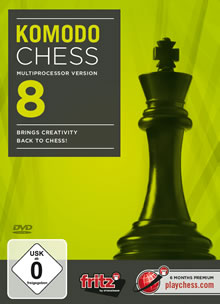 Chess Programs
Chess Programs
Komodo 8
http://www.chessbase.com
E-Mail
info@chessbase.com
Price €79.90
System requirements
Minimum: Pentium III 1 GHz, 2 GB RAM, Windows Vista, XP (Service Pack
3), 7/8, DirectX9, 256 MB graphics card, DVD-ROM drive, Windows Media
Player 9 and Internet access for program activation, access to
Playchess.com, Let’s Check and program updates. Recommended: PC Intel
i7 (Quadcore), 4 GB RAM, Windows 8.1, DirectX10, 512 MB graphics card,
100% DirectX10-compatible sound card, Windows Media Player 11, DVD-ROM
drive and Internet access for program activation, access to
Playchess.com, Let's Check and program updates. *Syzygy tablebases not
included!
Komodo is a very strong chess engine that is rated in the top three on
most major chess engine rating lists. It heavily relies on evaluation
rather than depth, and thus has a distinctive positional style. Its
forte is to play when there is nothing to play,Komodo author Don Dailey
described it as "In positions that most engines would likely struggle
or find it impossible to make progress, Komodo quietly prepares a break
and ends up with the victory."
The endgame of Komodo has been improved by the use of Syzygy tablebases
and that makes him at this moment the best buy!
This ChessBase package comes with: The new Deep Fritz 64-bit program
interface (+ 32 bit program interface)
Online access to the world’s largest analysis database “Let’s Check”,
with over 200 million extensively analysed
Positions,
Access to ChessBase engine cloud,
Premium membership to Playchess.com (6 months) plus a impressive
database of 1.5 million games plus a surprising strong
openings book.
ChessBase recommends a PC Intel i7 (Quadcore) with 4 GB RAM
but Komodo runs perfect on my 2 Quad with Windows 7
But first a practical experience with Komodo 8: 1.e4 c5 2.Nf3 d6 3.d4
cxd4 4.Nxd4 Nf6 5.Nc3 a6 6.Bg5 e6 7.f4 Qb6 8.Qd2 Qxb2 9.Rb1 Qa3 10.e5
dxe5 11.fxe5 Nfd7 12.Ne4 h6 13.Bh4 Qxa2 14.Rd1 Qd5 15.Qe3 Qxe5 16.Be2
Bc5 17.Bg3 Bxd4 18.Rxd4 Qa5+ 19.Rd2 0-0 20.Bd6 and now my Komodo8 is
able to find the best move here and that is 20….Nc6!
Please also see Informator 119 game 77.
Komodo is positional chess monster but he as all the other engines I
have on my computer could not find the brilliant move from Emanuel
lasker:
Marshall,Frank James - Lasker,Emanuel [C65]
World Championship 07th USA (1), 26.01.1907
1.e4 e5 2.Nf3 Nc6 3.Bb5 Nf6 4.d4 exd4 5.0-0 Be7 6.e5 Ne4 7.Nxd4 0-0
8.Nf5 d5 9.Bxc6 bxc6 10.Nxe7+ Qxe7 11.Re1 Qh4 12.Be3 f6 13.f3 fxe5
14.fxe4 d4 15.g3 Qf6 16.Bxd4 exd4 17.Rf1 Qxf1+ 18.Qxf1 Rxf1+ 19.Kxf1
Rb8 20.b3 Rb5
Nearly all engines hang here on 20…Ba6+.
But Komodo 8 has no problems finding 25…Rh6! {21.c4 Rh5 22.Kg1 c5
23.Nd2 Kf7 24.Rf1+ Ke7 25.a3 Rh6}
Interesting to mention is that Komodo 8 finds,in the Two Knights
Defence:the strong 1.e4 e5 2.Nf3 Nc6 3.Bc4 Nf6 4.Ng5 d5 5.exd5 Na5
6.Bb5+ c6 7.dxc6 bxc6 8.Bd3 Nd5 9.Nf3 Bd6 10.0-0 Nf4 11.Nc3 Nxd3
12.cxd3 c5 !
In the famous game, Spassky,Boris V (2660) - Fischer,Robert James
(2785) [E56]
World Championship 28th Reykjavik (1), 11.07.1972
1.d4 Nf6 2.c4 e6 3.Nf3 d5 4.Nc3 Bb4 5.e3 0-0 6.Bd3 c5 7.0-0 Nc6 8.a3
Ba5 9.Ne2 dxc4 10.Bxc4 Bb6 11.dxc5 Qxd1 12.Rxd1 Bxc5 13.b4 Be7 14.Bb2
Bd7 15.Rac1 Rfd8 16.Ned4 Nxd4 17.Nxd4 Ba4 18.Bb3 Bxb3 19.Nxb3 Rxd1+
20.Rxd1 Rc8 21.Kf1 Kf8 22.Ke2 Ne4 23.Rc1 Rxc1 24.Bxc1 f6 25.Na5 Nd6
26.Kd3 Bd8 27.Nc4 Bc7 28.Nxd6 Bxd6 29.b5 Bxh2 30.g3 h5 31.Ke2 h4 32.Kf3
Ke7 33.Kg2 hxg3 34.fxg3 Bxg3 35.Kxg3 Kd6 36.a4 Kd5 37.Ba3 Ke4 38.Bc5 a6
39.b6 f5 40.Kh4 f4 41.exf4 Kxf4 42.Kh5 Kf5 43.Be3 Ke4 44.Bf2 Kf5 45.Bh4
e5 46.Bg5 e4 47.Be3 Kf6 48.Kg4 Ke5 49.Kg5 Kd5 50.Kf5 a5 51.Bf2 g5
52.Kxg5 Kc4 53.Kf5 Kb4 54.Kxe4 Kxa4 55.Kd5 Kb5 56.Kd6 1-0,Komodo goes
for 29…Kf7.
Pleasant to mention is that Komodo 8 has no problems finding the
winning 26.Bd1!
Spassky,Boris V (2660) - Fischer,Robert James (2785) [E41]
World Championship 28th Reykjavik (5), 20.07.1972
1.d4 Nf6 2.c4 e6 3.Nc3 Bb4 4.Nf3 c5 5.e3 Nc6 6.Bd3 Bxc3+ 7.bxc3 d6 8.e4
e5 9.d5 Ne7 10.Nh4 h6 11.f4 Ng6 12.Nxg6 fxg6 13.fxe5 dxe5 14.Be3 b6
15.0-0 0-0 16.a4 a5 17.Rb1 Bd7 18.Rb2 Rb8 19.Rbf2 Qe7 20.Bc2 g5 21.Bd2
Qe8 22.Be1 Qg6 23.Qd3 Nh5 24.Rxf8+ Rxf8 25.Rxf8+ Kxf8 26.Bd1 Nf4
27.Qc2?? Bxa4 0-1. Spassky made a terrible blunder with 27.Qc2 and
Purdy wrote in his book Extreme Chess instructively:Spassky had thought
too long and was now worried by his clock. He undoubtedly busied
himself wondering if black had a positional win. Diving deep,Spassky
missed something floating on the surface.It seems that even a World
Champion should not neglect my oftrepeated rule: Examine all checks and
all captures!
So far human was superior in positional play but I fear this all will
end
with Komodo 8!
By the way if you only see one cpu engine running on your dual core
machine,please click on cpu and change it to 4.
Conclusion: A hell of a chess machine!
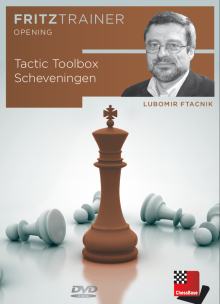 TrainingOpeningFriztrainer
TrainingOpeningFriztrainer
Tactic Toolbox Scheveningen
by Lubomir Ftacnik
2014
http://www.chessbase.com
E-Mail info@chessbase.com
Price Euro 27.90
Pentium-Processor at 300 Mhz or higher, 64 MB RAM, Windows XP, Windows
Vista, Windows 7, DVD drive, mouse, soundcard
Grandmaster Lubomir Ftacnik provide the user of this DVD with a
impressive over 7hours video entertainment based on the Scheveningen
Defence,a opening that takes us back to ex world champion Dr.Max Euwe
who adopted this defence in the 1923 Scheveningen master tournament
that gave it its name.
But Anderssen and Paulsen liked to place their pawns on e6 and d6 as
far back in the 19th century.
Ftacnik does not only cover games but explains also all the strategies
of this defence as attacks on the king’s side, attacks on the h-file
and more.
But there is also a wealth of smashing games as for example the
following lost from Ftacnik,where the author does not fear to throw his
secrets of the Scheveningen away: Almasi,Zoltan (2640) -
Ftacnik,Lubomir (2612) [B82] Bundesliga 0506 Germany (4.2), 13.11.2005
1.e4 c5 2.Nf3 d6 3.d4 cxd4 4.Nxd4 Nf6 5.Nc3 e6 6.Be3 Be7 7.f4 Nc6 8.Qf3
Bd7 9.0-0-0 Nxd4 10.Bxd4 Bc6 11.g4 0-0 12.g5 Nd7 13.h4 Qa5 14.Kb1 b5
15.f5 Ne5 16.Bxe5 dxe5 17.fxe6 Bb4 18.e7 Bxe7 19.Nd5 Bxd5 20.exd5 Rad8
21.Bd3 b4 22.h5 Qb6 23.Qe4 g6 24.hxg6 fxg6 25.d6 Bxg5 26.Qxe5 Bf6
27.Qd5+ Kg7 28.Rxh7+ 1-0.
But as we can see in the following game,this DVD is made by renowned
Sicilian expert!
Nunn,John DM (2600) - Ftacnik,Lubomir (2500) [B80]
Naestved Naestved (1), 1985
1.e4 c5 2.Nf3 d6 3.d4 Nf6 4.Nc3 cxd4 5.Nxd4 a6 6.Be3 e6 7.Qd2 b5 8.f3
Bb7 9.g4 h6 10.0-0-0 Nbd7 11.Bd3 b4 12.Nce2 d5 13.exd5 Nxd5 14.Nf4 Bd6
15.Nh5 Be5 16.Rhe1 Qa5 17.Kb1 Nc3+ 18.bxc3 bxc3 19.Qc1 Bxd4 20.Bxd4 Bd5
21.a3 Rb8+ 22.Ka1 Rb2 23.Nxg7+ Kf8 24.Qxb2 cxb2+ 25.Bxb2 Rg8 26.Nh5
Bxf3 27.Be2 Bxg4 28.Ng3 Ke7 29.Ne4 Bf5 30.Nd6 Bxc2 31.Nc4 Qa4 32.Rd6
Rb8 33.Rf1 Rxb2 34.Kxb2 Qb3+ 35.Kc1 Qc3 36.Rxd7+ Kxd7 37.Rxf7+ Kd8 0-1.
Available in two languages German and English!
Conclusion: This DVD offers a lot of
value for your maney!
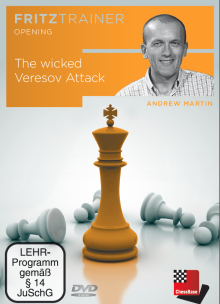 TrainingOpeningFriztrainer
TrainingOpeningFriztrainer
The wicked Veresov Attack
by Andrew Martin
2014
http://www.chessbase.com
E-Mail info@chessbase.com
Price Euro 27.90
Pentium-Processor at 300 Mhz or higher, 64 MB RAM, Windows XP, Windows
Vista, Windows 7, DVD drive, mouse, soundcard
Andrew Martin does not only explain the tricky Veresov,but arms the
user with a selection well thought repertoire lines.
As we can learn from Andrew Martin the Veresov is more than playing
simple moves as 1.d4,Nc3,Bg5 and f3!
A fine example that I found on this well filled DVD comes the
great attacking genius Jonny Hector:
Hector,Jonny (2570) - Koneru,Humpy (2496) [C13]
Corus-B Wijk aan Zee (6), 18.01.2003
1.d4 d5 2.Nc3 Nf6 3.Bg5 Nbd7 4.Qd3 e6 5.e4 dxe4 6.Nxe4 Be7 7.Nxf6+ Bxf6
8.Bxf6 Qxf6 9.Nf3 0-0 10.Qe3 c5 11.0-0-0 b6 12.Bb5 cxd4 13.Rxd4 Qe7
14.Bc6 Rb8 15.Rhd1 Nf6 16.Qe5 Ba6 17.Ra4 Rbc8 18.Nd4 Ng4 19.Qf4 h5
20.Rxa6 e5 21.Nf5 Qf6 22.Qf3 Rxc6 23.Qxc6 Qxf5 24.Qf3 Qg5+ 25.Kb1 Nxh2
26.Qg3 Ng4 27.f3 Rd8 28.Rxd8+ Qxd8 29.Qe1 Nf6 30.Rxa7 e4 31.fxe4 Nxe4
32.a4 f5 33.Qe2 Qg5 34.Rb7 Qg6 35.Qb5 Qg4 36.Rxb6 h4 37.a5 Nd2+ 38.Ka2
Nc4 39.Rc6 Ne3 40.a6 Qd4 41.c3 1-0.
A mystery is the game Hector,Jonny (2546) - Berg,Emanuel (2474) [D03]
Skelleftea Solett op Skelleftea (9), 16.04.2001
1.Nc3 d5 2.d4 e6 3.Nf3 Nf6 4.Bg5 Bb4 5.Qd3 h6 6.Bxf6 Qxf6 7.a3 Bd6 8.e4
dxe4 9.Nxe4 Qe7 10.g3 0-0 11.Bg2 Nd7 12.c4 c6 13.0-0 Bc7 14.Rfe1 Rd8
15.Rad1 ½-½ ,Objectively speaking white’s position looks
very attractive, with a nice space advantage and well placed forces.By
the way 4…Bb4 is the MacCutcheon move order.
Video running time is 4 hours and 24 minutes.
Conclusion: Well researched chess
DVD!
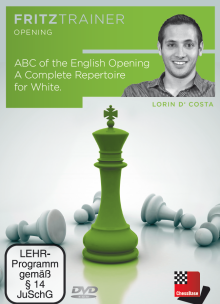
TrainingOpeningFriztrainer
ABC of the English Opening
by Lorin D'Costa
2014
http://www.chessbase.com
E-Mail info@chessbase.com
Price Euro 27.90
Pentium-Processor at 300 Mhz or higher, 64 MB RAM, Windows XP, Windows
Vista, Windows 7, DVD drive, mouse, soundcard
The well known Lorin D'Costa explains in a impressive 7 hours the
secrets of the English Opening.
The author explains in video files lines as 1.c4 e5, 1.c4 c5
{Symmetrical English},and all kind of 1.c4 alternatives as the Slav,
Kings Indian, Grunfeld and b6.
The English Opening is very popular at all levels of play ,from up and
on coming players to World Champions.
The move 1…e5 leads to a reversed Sicilian and the Symmetrical English
can easy arise from different openings as the Semi Tarrasch and
this all is well explained by the author.
Game 34 handles the bishop fianchetto: Sehner,Norbert (2420) -
Schmitzer,Klaus (2300) [A10]
BL2-West 9192 Germany (4.3), 1992
1.c4 b6 2.Nc3 Bb7 3.e4 e6 4.Nge2 Bb4 5.g3 f5 6.Bg2 fxe4 7.d3 Nf6 8.0-0
0-0 9.dxe4 Nc6 10.h3 e5 11.a3 Be7 12.Nd5 Ne8 13.b4 Bg5
14.Bb2 Nd6 15.Qd3 a6 16.Nxb6 Nxe4 17.Bxe4 cxb6 18.b5 axb5 19.cxb5 Kh8
20.bxc6 Ba6 21.Qc2 d5 22.Rad1 Qc8 23.Rxd5 Qxh3
24.Bxe5 Rf7 25.Bd4 Qg4 26.f3 1-0,but Lorin D'Costa provides the user
with a reliable weapon but Christian Bauer in his book Play 1…b6
prefers 4….Nf6!
Conclusion: Lorin D'Costa provides the user with a detailed coverage of
this important opening!
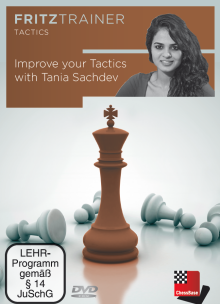
TrainingMiddlegameFritztrainer
Improve your Tactics
by Tania Sachdev
2014
http://www.chessbase.com
E-Mail info@chessbase.com
Price Euro 27.90
Pentium-Processor at 300 Mhz or higher, 64 MB RAM, Windows XP, Windows
Vista, Windows 7, DVD drive, mouse, soundcard
The bright Tania Sachdev explains in a small four hours the secrets of
tactics,where she learns you how to place your pieces for a smashing
combination.
As we can learn this is all a matter of judgement and planning.
A fine example of explantion is: Capablanca,Jose Raul - Chase,A [C33]
New York sim1 New York, 23.02.1922
1.e4 e5 2.f4 exf4 3.Qf3 Nc6 4.c3 Nf6 5.d4 d5 6.e5 Ne4 7.Bxf4 g5 8.Be3
h5 9.Nd2 Bg4 10.Nxe4 Bxf3 11.Nf6+ Ke7 12.Nxf3 Bh6
13.Nxg5 Bg7 14.Bd3 Bxf6 15.0-0 Qg8 16.Rxf6 Rf8 17.Raf1 Nd8 18.b4 Qg7
19.a4 Ke8 20.b5 b6 21.Be2 Ne6 22.Bf3 Nxg5
23.Bxg5 Qh7 24.Bxd5 Qd3 25.Bc6+ 1-0
Tania Sachdev aim is that You can never spend too little
time solving combinations and studies to improve your calculating
abilities!.
And that are wise words!
Conclusion:Smashing DVD!








